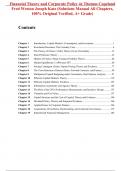Financial Theory and Corporate Policy 4e Thomas Copeland
Fred Weston Joseph Katz (Solutions Manual All Chapters,
100% Original Verified, A+ Grade)
Contents
Chapter 1 Introduction: Capital Markets, Consumption, and Investment ............................... 1
Chapter 2 Investment Decisions: The Certainty Case.............................................................. 6
Chapter 3 The Theory of Choice: Utility Theory Given Uncertainty .................................... 13
Chapter 4 State Preference Theory ........................................................................................ 32
Chapter 5 Objects of Choice: Mean-Variance Portfolio Theory ........................................... 44
Chapter 6 Market Equilibrium: CAPM and APT .................................................................. 60
Chapter 7 Pricing Contingent Claims: Option Pricing Theory and Evidence ....................... 77
Chapter 8 The Term Structure of Interest Rates, Forward Contracts, and Futures ................ 90
Chapter 9 Multiperiod Capital Budgeting under Uncertainty: Real Options Analysis .......... 97
Chapter 10 Efficient Capital Markets: Theory ....................................................................... 119
Chapter 11 Efficient Capital Markets: Evidence ................................................................... 125
Chapter 12 Information Asymmetry and Agency Theory ..................................................... 128
Chapter 13 The Role of the CFO, Performance Measurement, and Incentive Design .......... 133
Chapter 14 Valuation and Tax Policy .................................................................................... 137
Chapter 15 Capital Structure and the Cost of Capital: Theory and Evidence ........................ 140
Chapter 16 Dividend Policy: Theory and Empirical Evidence .............................................. 160
Chapter 17 Applied Issues in Corporate Finance ................................................................... 166
Chapter 18 Acquisitions, Divestitures, Restructuring, and Corporate Governance ............... 172
Chapter 19 International Financial Management ................................................................... 184
,Chapter 1
Introduction: Capital Markets,
Consumption, and Investment
1. Assume the individual is initially endowed, at point A, with current income of y0 and end-of-period
income of y1. Using the market rate, the present value of his endowment is his current wealth, W0:
y1
W0 = y0 +
1 + rf
The individual will take on investment up to the point where the marginal rate of return on investment
Figure S1.1 Fisher separation for the lender case
equals the market rate of interest at point B. This determines the optimal investment in production (P0,
P1). Finally, in order to achieve his maximum utility (on indifference curve U1) the individual will lend
(i.e., consume less than P0) along the capital market line until he reaches point C. At this point his
optimal consumption is C0 , C1 which has a present value of
C1
W0 = C0 +
1 + rf
,2 Copeland/Shastri/Weston • Financial Theory and Corporate Policy, Fourth Edition
2.
Figure S1.2 An exogenous decline in the interest rate
(a) An exogenous decrease in the interest rate shifts the capital market line from the line through AW 0
to the line through AW0. Borrowers originally chose levels of current consumption to the right of
A. After the decrease in interest rate, their utility has increased unambiguously from UB to UB .
The case for those who were originally lenders is ambiguous. Some individuals who were lenders
become borrowers under the new, lower, rate, and experience an increase in utility from UL 1 to
UB1 . The remaining lenders experience a decrease in utility, from U L to U L .
2 2
(b) Because borrowers and lenders face the same investment opportunity set and choose the same
optimal investment (at A before the interest rate decreases and at A’ afterward), current wealth is
the intercept of the capital market line with the C0 axis. Originally it is at W0; then it increases
to W0 .
(c) The amount of investment increases from I to I’.
3. Assuming that there are no opportunity costs or spoilage costs associated with storage, then the rate of
return from storage is zero. This implies a capital market line with a 45 slope (a slope of minus 1) as
shown in Figure S1.3.
Figure S1.3 Market rate cannot fall below net rate from storage
, Chapter 1 Introduction: Capital Markets, Consumption, and Investment 3
Also shown is a line with lower absolute slope, which represents a negative borrowing and lending
rate. Any rational investor would choose to store forward from his initial endowment (at y0, y1) rather
than lending (to the left of y0). He would also prefer to borrow at a negative rate rather than storing
backward (i.e., consuming tomorrow’s endowment today). These dominant alternatives are
represented by the heavy lines in Figure S1.3. However, one of them is not feasible. In order to borrow
at a negative rate it is necessary that someone lend at a negative rate. Clearly, no one will be willing to
do so because storage at a zero rate of interest is better than lending at a negative rate. Consequently,
points along line segment YZ in Figure S1.3 are infeasible. The conclusion is that the market rate of
interest cannot fall below the storage rate.
4. Assume that Robinson Crusoe has an endowment of y0 coconuts now and y1 coconuts which will
mature at the end of the time period. If his time preference is such that he desires to save some of his
current consumption and store it, he will do so and move to point A in Figure S1.4. In this case he is
storing forward.
Figure S1.4 Storage as the only investment
On the other hand, if the individual wishes to consume more than his current supply of coconuts in
order to move to point B, it may not be possible. If next year’s coconut supply does not mature until
then, it may be impossible to store coconuts backward. If we were not assuming a Robinson Crusoe
economy, then exchange would make it possible to attain point B. An individual who wished to
consume more than his current allocation of wealth could contract with other individuals for some of
their wealth today in return for some of his future wealth.




